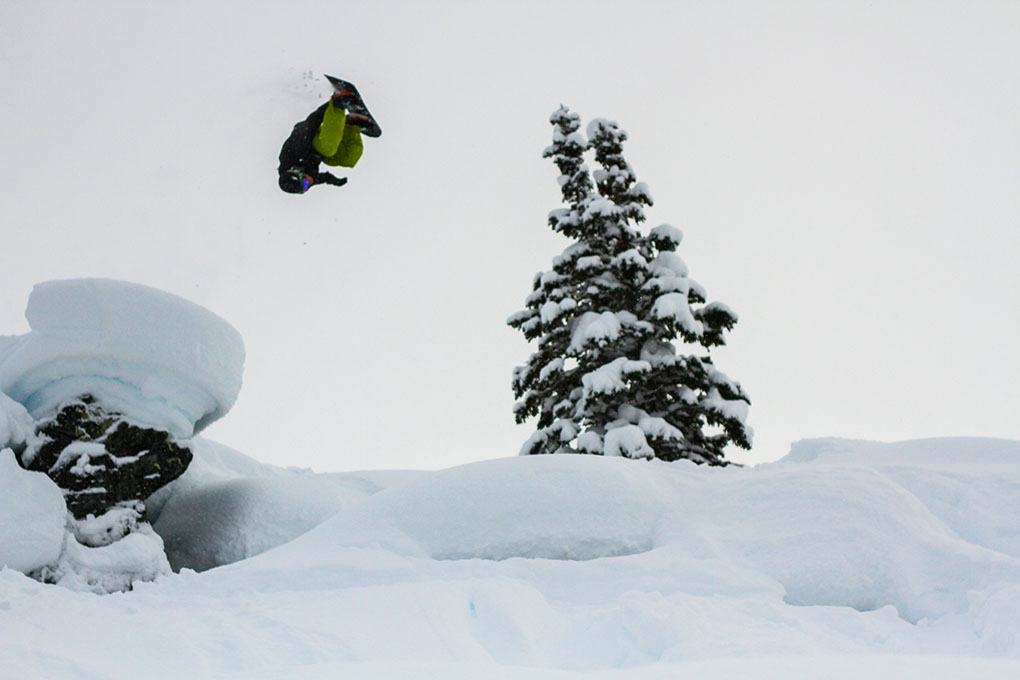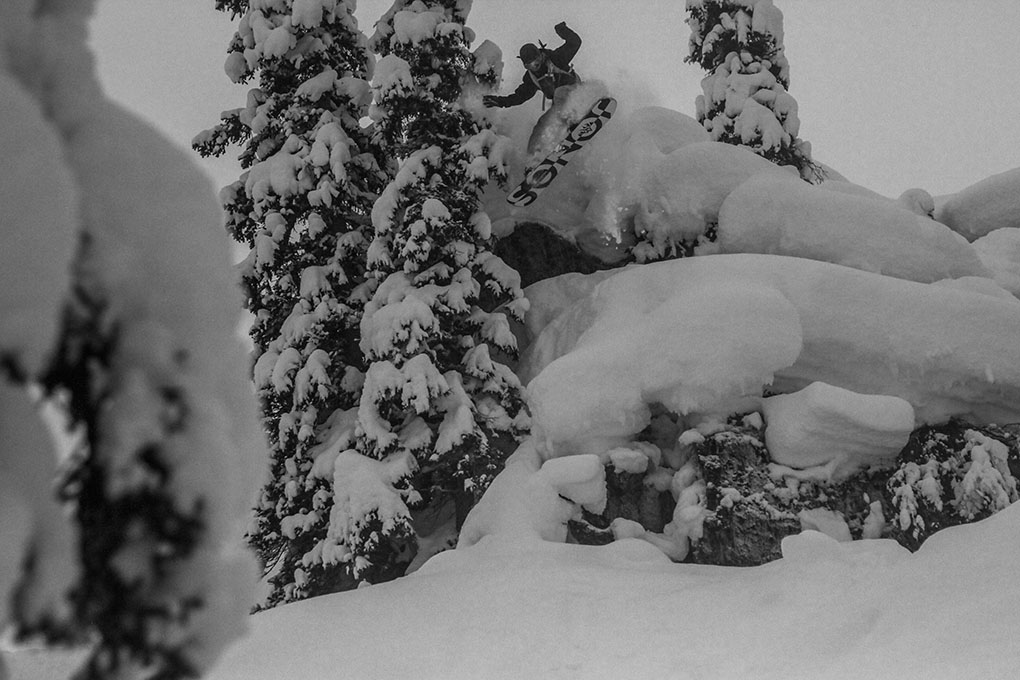Liner
The boot can be bought with several different liners: Comfort Flex, Performance Flex, and Thermo Flex. I opted for the ThermoFlex Premium boot liner with “a leather lining that provides unsurpassed comfort and aids in regulating moisture… these liners are designed to be heat-formed to your feet, providing a fit that is truly customized.”
While the leather heel pocket with L-shaped inserts succeeded in keeping my heel secure and preventing heel lift, the break-in time was somewhat brutal. It took 10-20 days, and resulted in serious blisters from the L-heel inserts.
The leather is quite comfortable when dry, but once the leather and liner becomes saturated, the inserts become major rubbing zones which took a lot of time (and pain) to get used to.
But after I paid my dues and built up some scar tissue, the heel cup did an amazing job both on the ascent and descent. These boots may take considerable breaking in—especially if you’re transferring from a flatter, all mountain or freeride boot (such as the Kaiju)—but in my opinion, it’s well worth the sacrifice when a more durable boot is needed to excel and provide confidence in alpine environments.

The liner features a 3-layer moisture wicking system. The combination does a satisfactory job keeping my notoriously sweaty feet from flooding the shell on those warmer spring days, yet remains warm enough for extended trips below 0 degrees.
The liners feature a “heel harness” typical of most snowboarding boots to ensure a tight fit around the ankle and heel. It performs very well, and makes the liner wearable as a warm “bootie” for the hut or tent.
Waterproofing
The Sympatex “waterproofing and breathability of 25000g/m²” lasted for approximately 80-90 days, then slowly deteriorated over time. The lack of waterproofing may also be related to heavy crampon use and slight delamination of the sole at the toe (where the crampon straps hit the boot) and many miles of biking and bushwacking through alpine and forested terrain.
Touring
As I mentioned earlier, the high heel of the Vibram sole takes some getting used to if transitioning from a softer, flat-soled freeride or park boot. I noticed this primarily when walking on flat ground. But when climbing anything over 20 degrees, the stance felt very comfortable and perhaps more aggressive and efficient for skinning.
Climbing & Crampon-Compatibility
Although the Independent BC can’t compete with mountaineering boots for technical terrain, it may be one of the best options if you’re looking for a snowboard / splitboard boot to hike and climb in.
The larger profile of the boot does prohibit it from working with certain models of semi-automatic crampons, as the heel of the sole is too wide for the heel lever on narrower models to get over the sole and firmly onto the heel welt. But it’s possible that a smaller boot size may work better with the crampons I found to be problematic (specifically Grivel models) since the sole should be smaller and narrower. I found that the semi-automatic Black Diamond Cyborg or Petzl Sarken crampon work the best with boot sizes 8.5-10.5. The boot handles the crampons well, although they are not as ideal for climbing ice as mountaineering boots due to the bulkiness and flexibility. I tested out the combination several times ice climbing, and for anything technical, the size of the toe can prevent the crampon front points from driving into the ice properly.
The Independent BC is one of the best options for an all around backcountry/ splitboarding boot, although I would like to try the Fitwell splitboarding boot. I have only heard positive things about Fitwell, specifically how well they climb and ride. They resemble a mountaineering boot more so than the Independent BC, and have a much sleeker profile that can be beneficial when kicking steps. (But the Italian-made Fitwells are not cheap, with an MSRP of $635.95.)
Riding
The Independent BC has support in all the right places, yet remains semi-playful. Although the heel height took some getting used to (both touring and riding) the high heel lugs seem to translate to faster edging and shifting of weight, as well as a comfortable stance for long traverses while snowboarding.
The boot fills the binding very nicely due to its robust profile, and rides very comfortably in high-backed bindings. The Surlyn backstay grips the back of the binding exceptionally well, while adding stiffness, responsiveness, and durability to the boot.
The Independent BC is not as playful as most freeride and all-mountain boots, but it does allow enough articulation to have fun launching cliffs or hitting booters in the backcountry. I normally don’t hit large jumps on my splitboard, but a series of weather days on glaciers with limited visibility got me restless. And thankfully, these boots handled everything I threw at them.
I’ve also never had any significant boot rub or foot pains while descending. The padded tongue and calf area reduce rubbing, as well as “calf and shin bite.” The upper padded region can really stiffen up the boot when laced accordingly, while still maintaining a nice flex in the ankles. (It’s similar to the Nike Kaiju in that regard.)

Although only rated a 5 out of 10 for stiffness, the Independant BC was stiff enough for most of my use; however, the Alaska Range trip made me realize that a stiffer boot is needed when more time is spent mountaineering than snowboarding. The Fitwell splitboarding boot might be a better candidate, but that’s just speculation for the time being.
Durability (& Comparisons)
Overall, I am very pleased with how the Independent BC has held up for roughly a season and half. Besides the toe of the boot delaminating a little bit and a minor crampon puncture, the boot is in good condition and retains its stiffness. The sole still looks new, which is impressive given how many miles they have traveled.
During my Alaska Range trip, two of my partners had different models of the Deeluxe boots: the Spark Summits and XV. This provided an opportunity to compare them to my Independent BC’s over a 26-day period. Although our board setups varied, we would all trek along the same terrain, step by step on most occasions. The results were clear: the Independent BC was by far the most durable and trustworthy; the other two splitboarders saw their C3 speed lacing systems fail.
The XV inner-locking mechanism broke first within about 30 days of normal use while on the Ruth Glacier. The Spark Summit lasted longer (50+ days), however both the Boa and C3 system failed catastrophically. Both the XV and Spark Summits were fixable in the backcountry, but required additional support from wrapping cordellete around the ankles of the boots.
Another issue I observed with the Spark Summit, XV, and Independent BC seemed to result from crampon use. The soft, insulated boots did not hold up well to cinching down the toe straps of the crampons. The pressure on the toe caused the Vibram sole to delaminate from the foam that joins the sole to the boot chassis. Over the course of the season, the delamination spread slowly toward the heel, and was temporarily fixed with ShoeGoo.
Despite the minor delamination I experienced, the Independent BC remains fully functional and comfortable, with original laces and after 120 days of use.
Bottom Line
The Deeluxe Independent BC is a well-designed boot that performs well on both the ascent and descent, yet remains affordable and durable. If you are looking for a high-end snowboarding boot that can take you comfortably into the backcountry, the Independent BC is an obvious choice.
